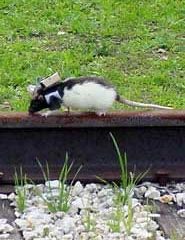
A University of Ulster researcher has discovered a new population of cave dwelling crocodiles, never before seen outside their Saharan habitat.
PhD student Tara Shine discovered the cave dwelling crocodiles while living in the remote African country of Mauritania as part of a two and a half year volunteer project.
Previously unknown, except by local tribespeople, the crocodiles live in burrows and caves throughout the dry season and periods of drought – a phenomenon never

A novel prototype light meter has been developed by researchers in New York. Published today in the Institute of Physics journal, Measurement Science and Technology, this new retinal flux density meter will provide an affordable tool for measuring light at all levels and might ultimately lead to new standards to improve both energy efficiency and safety at night.
The retina in the eye detects light using cells called rods and cones. At high light levels, such as in daylight, the cones detec

The key role of computer technology in the fine-tuning of drug development and design will be considered by Professor Stephen Muggleton of Imperial College, London in his inaugural lecture, Models of Mind and Models of Body, today.
The new Professor of Bioinformatics in the Department of Computing will focus on how machine learning and logic programming can reduce the high costs of drug development in the pharmaceutical industry.
The pharmaceutical industry is increasingly overwhelm

Jubilant astronomers today unveiled humankind`s most spectacular views of the Universe as captured by the NASA/ESA Hubble Space Telescope`s new Advanced Camera for Surveys (ACS). They also reported that Hubble is operating superbly since the March servicing mission and are looking forward to more pictures from the newly revived NICMOS camera.
“The ACS is opening a wide new window onto the Universe. These are among the best images of the distant Universe humans have ever seen,” says Johns Hop

Dark-matter detector could pin down the Universe’s missing mass.
Researchers in London are building a cheap dark-matter detector that should be able to spot the exotic particles called WIMPs that are suspected of hiding most of the Universe’s missing mass 1 .
A prototype of the detector has just shown, for the first time, that it can spot something as close to a WIMP as it’s possible to produce in the lab.
WIMP stands for ’weakly interacting massiv

Desire drives remote-controlled rodents.
Remote-controlled rats could soon be detecting earthquake survivors or leading bomb-disposal teams to buried land mines.
Signals from a laptop up to 500 metres away make the rats run, climb, jump and even cross brightly lit open spaces, contrary to their instincts. The rodents carry a backpack containing a radio receiver and a power source that transmits the signals into their brains through electrical probes the breadth of a hair.

– new calculation confirms standard model of particle physics. Contribution of hadronic vacuum polarization determined with unprecedented accuracy. The magnetic moment of the muon is an important precision parameter for…
Technique may prevent formation of unwanted waves that siphon off needed energy. Heating plasma to the ultra-high temperatures needed for fusion reactions requires more than turning the dial on a…

An international team of astronomers, led by researchers from the Astronomical Observatory of the University of Warsaw, have identified a new class of cosmic X-ray sources. The findings have been…

Antibody that Neutralizes Inhibitory Factors Involved in Nerve Regeneration Leads to Enhanced Motor Function after Acute Spinal Cord Injury. Researchers at 13 clinics in Germany, Switzerland, the Czech Republic and…

How the body’s natural killer cells could fight leukemia. Every year, some 13,000 people in Germany are diagnosed with leukemia. Despite intensive chemotherapy, around one in two of them die….

… eco-friendly reactor converts air and water into ammonia. Producing enough ammonia to feed the world comes with a large carbon footprint;. process described in new UB-led study could help…

How simulations help manufacturing of modern displays. Modern materials must be recyclable and sustainable. Consumer electronics is no exception, with organic light-emitting diodes (OLEDs) taking over modern televisions and portable…

“Neurons that fire together, wire together” describes the neural plasticity seen in human brains, but neurons grown in a dish don’t seem to follow these rules. Neurons that are cultured…

The quest for sustainable energy solutions has been a major focus of scientific research for decades. Solar energy, a clean and renewable source, has emerged as a promising alternative to…

With a processing speed a billion times faster than nature, chip-based laser neuron could help advance AI tasks such as pattern recognition and sequence prediction. Researchers have developed a laser-based…

New technology could remotely identify various types of plastics, offering a valuable tool for future monitoring and analysis of oceanic plastic pollution. Researchers have developed a new hyperspectral Raman imaging…

Artificial Intelligence (AI) has established a strong presence across industries, large and small. The “VoBaKI” research project has empowered small and medium-sized enterprises (SMEs) with an innovative tool to independently…